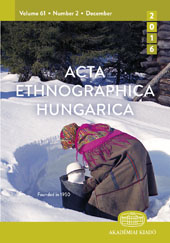The Security of Hope - The Confraternity of the Living Rosary
The Security of Hope - The Confraternity of the Living Rosary
Author(s): Gábor BarnaSubject(s): Cultural history, Social history, 19th Century, Pre-WW I & WW I (1900 -1919), Interwar Period (1920 - 1939), History of Religion
Published by: Akadémiai Kiadó
Keywords: Living Rosary Association; rosary; feminisation; individual and communal religious practice; the security of hope;
Summary/Abstract: The Living Rosary Association, a renewed form of the rosary confraternity, was principally an association of the peasantry and lower social strata in Hungary. The paper presents and interprets the confraternity practice of a settlement (Kunszentmárton, Jász-Nagykun-Szolnok County on the Hungarian Great Plain), through confraternity minutes (1851–1940), the fraternity’s religious literature and journal, interviews and comparison with other fraternities. The rosary was principally a form of female devotion. However, up to the 1940s the leaders were men. The high degree of feminisation can be interpreted in the frame of the process of secularisation. In the course of the processes of economic, social and cultural modernisation, the tasks of the private sphere within the family (running the household, raising children) fell to women. Within this frame they also provided for the family’s sacral world. Until the 1940s the rosary confraternity preserved its character as a women’s mass movement. At the turn of the 19th–20th century the prayer groups were organized on a family and neighbourhood basis. The confraternity also established its own funeral society, linking the living and the dead in prayer. Among the reasons for the popularity of the rosary were its democratic nature and the clear religious goals: it provided the faithful with an institutional frame for their charitable activity; it set readily understandable and easily performed tasks for its members; it required the acceptable co-ordination of individual and communal forms of religious practice. The prayer had a flexible spatial and temporal structure, that is, the prayers could be said at any time and anywhere, even during work. This ensured for devotions a required intimacy but at the same time also a communal character.
Journal: Acta Ethnographica Hungarica
- Issue Year: 51/2006
- Issue No: 3-4
- Page Range: 345-356
- Page Count: 12
- Language: English
- Content File-PDF

